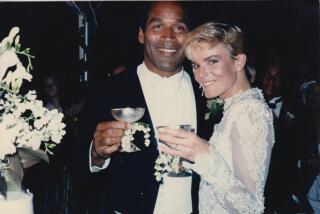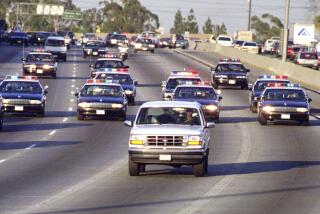THE O.J. SIMPSON MURDER TRIAL
- Share via
UCLA law professor Peter Arenella and Loyola University law professor Laurie Levenson offer their take on the Simpson trial. Joining them is Southwestern University law professor Myrna Raeder. Today’s topic: A smooth witness tackles flying DNA and other hypotheticals.
PETER ARENELLA
On the prosecution: Good lawyering. Superb expert witness. After providing staggering statistics suggesting the infallibility of DNA results confirmed by two labs, Rock Harmon used hypotheticals to ridicule defense claims about how easily evidence can be contaminated by sneezing, coughing criminalists. Gary Sims’ PCR results showing Nicole Simpson’s genetic markers in blood under her fingernails undercut claims that an unknown assailant’s blood was found there.
On the defense: Barry Scheck’s cross pushed a simple theme: The strength of DNA results can only be as good as the weakest link in the chain of criminalists handling the evidence. Scheck converted Sims’ care in handling evidence to illustrate shoddy LAPD procedures that created a risk of cross-contamination. And where little degradation was found, such as the Bundy rear gate stain, Scheck used its absence to imply the blood must have been planted.
LAURIE LEVENSON
On the prosecution: Neither sneeze nor sweat nor dandruff will transfer DNA. Sims’ testimony corroborated the work by Cellmark and showed that cross-contamination is unlikely. He also boosted the importance of PCR results. Sims must be a really good witness if Scheck is willing to concede that he’s not a conspirator trying to frame O.J. Sims has three of the most essential qualities of a good witness--he is likable, knowledgable and unbiased.
On the defense: Flaking, floating, aerosol DNA form the basis of Scheck’s cross-examination. Using charts right out of children’s TV, Scheck used Sims to show that cross-contamination is possible. Scheck also raised the issue of why DNA from the Bundy gate was less degraded than other blood spots collected at the scene. Still, Scheck didn’t explain why contamination would affect the swatches with O.J.’s blood but not the controls collected and kept with them.
MYRNA RAEDER
On the prosecution: Harmon has a knack of bringing the jury back to the visceral core of this case, the excessively brutal slayings. It was not chance that Sims’ direct ended with photos of Nicole’s bloody hands, ostensibly to debunk the defense theory that blood under her fingernails was that of a mystery assailant. The prosecution made good on its promise to present a mountain of DNA, which towers above that introduced in any other case.
On the defense: After Scheck established that Sims is not an expert in molecular biology or population genetics, he started educating jurors about contamination rather than directly attacking him. Trying to show that DNA can fly, Scheck resorted to simple but effective exhibits, perhaps a welcome relief to jurors on overload from the prosecution’s dense statistical charts. He ended with a flourish at the Bundy gate, raising the specter of conspiracy again.
Compiled by HENRY WEINSTEIN / Los Angeles Times
More to Read
Sign up for Essential California
The most important California stories and recommendations in your inbox every morning.
You may occasionally receive promotional content from the Los Angeles Times.










